How to Calculate Mortgage Payment
The longer the mortgage term, the less the mortgage payments will be each and every month. Therefore it’s not by coincidence that the most popular type of loan term is 30 years. Essentially, if all goes to plan, after 30 years of paying off a mortgage – the ownership of a property (title) will be fully paid and clear. Until then, the bank is essentially the homeowner. If not done properly, taking out a mortgage on a home is very risky as the buyer will be spending a premium on paying interest (about 40% of the purchase price) which the bank is happy to accept. Buyers can shop around at different banks and financial institutions to find the best interest rate. A fixed interest rate (meaning that the rate can not change over time) should always be chosen vs an adjustable interest rate. People who buy a house using a mortgage tend to believe that the market will improve in the near future and as a result, the value of the property will increase. If the property is sold at a higher price after a few years, the property owner can make money if the house can be sold at a higher amount than the purchase price.
Example
The following calculation is for a home to be bought for 1 million dollars with a 20% downpayment on a 30 year fixed mortgage.
- Loan Amount: $1,000,000
- Interest Rate: 3.92%
- Mortgage Period: 30 years
The monthly payment of the mortgage itself will be $4,728 and this does not factor in homeowners insurance, property taxes and other fees (depending on the type of property). At the end of 30 years, the homeowner will have paid a total of $1,702,333. If the homeowner had paid for the property full in cash at the time of purchase, they would have saved themselves $702,333 dollars.
Make Extra Mortgage Payments
Making extra payments and paying off a mortgage sooner rather than later can have the potential to save thousands of dollars. However, if the terms (rules) of the mortgage agreement do not allow the mortgagor to make extra payments, the lender may charge a penalty (fee) which defeats the purpose. Long-term loans that allow the borrower to make a balloon payment (lump sum payment) serves the same purpose and save thousands of dollars.
No Downpayment
There are two ways to qualify for a loan with no downpayment:
- Be a veteran;
- Be a customer with the Navy Federal Credit Union. The only way to be a customer with the Navy Federal Credit Union is to be enlisted in the armed forces, national guard, department of defense, or to have family ties to someone that is currently a member of the bank.
Mortgage Payment Calculator
Common terms you will see when using a mortgage payment calculator:
- Amortization – Commonly known as an amortization schedule, allows a borrower to see how the fixed payments every month are paying off the loan’s principal and interest.
- Balloon Payment – A lump sum payment that pays off the entire loan amount.
- Private Mortgage Insurance (PMI) – Obtaining a mortgage requires the borrower to put 20% down. If they put less than 20% down, they will need to obtain private mortgage insurance, increasing the monthly mortgage payment.
- Property Taxes – Property taxes are factored into the mortgage payment to help the borrower visualize the total amount needed to pay for the property.
- Homeowners Insurance – Not legally required, but it should be bought and be calculated into the total monthly amount going to paying off a home with a mortgage.
- HOA fees – When purchasing a condo or a property with shared common spaces, HOA fees must be paid each and every month.
